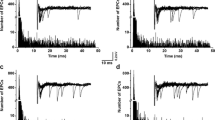Summary
Bass and Moore [Proc. Nat. Acad. Sci. 55:1214 (1966)] proposed that the vesicles containing acetylcholine undergo Brownian motion in the nerve terminals. Acetylcholine is released whenever a vesicle touches the inner face of the axolemma of the nerve terminal. The frequency at which contact is made is limited by an energy barrier that must be overcome before the vesicle can touch the axolemma. The energy barrier has two components. (1) An electrostatic repulsion between positive, fixed charges on the vesicles and a relatively positive potential at the face of the axolemma that is generated by the resting potential. (2) A layer of water molecules held to the vesicle by the surface charge. This model is inconsistent with experimental data. A modification of the model is presented. Both the vesicle and the inner face of the axolemma are assumed to have fixed, negative surface charges that are responsible for the energy barrier. By a series of simplifications, the model leads to two predictions. (1) A plot of the ln (miniature end plate potentials/sec) as a function of the concentration of ions in the axoplasm)−0.5 should give a straight line. (2) A plot of ln (end plate potential amplitudes) as a function of (extracellular Ca++ concentration)−0.5 should give a straight line. These predictions are shown to agree reasonably well with experimental data.
Similar content being viewed by others
References
Bass, L., Moore, W. J. 1966. Electrokinetic mechanism of miniature postsynaptic potentials.Proc. Nat. Acad. Sci. 55:1214
Blioch, Z. L., Glagoleva, I. M., Liberman, E. A., Nenashev, V. A. 1968. A study of the mechanisms of quantal transmitter release at a chemical synapse.J. Physiol. 199:11
Camejo, G., Villegas, G. M., Barnola, F. V., Villegas, R. 1969. Characterization of two different membrane fractions isolated from the first stellar nerves of the squid,Dosidicus gigas.Biochim. Biophys. Acta 193:247
Chandler, W. K., Hodgkin, A. L., Meves, H. 1965. The effect of changing the internal solution on sodium inactivation and related phenomena in giant axons.J. Physiol. 180:821
Danforth, W. H., Helmrich, E. 1964. Regulation of glycolysis in muscle. I. The conversion of phosphorylaseb to phosphorylasea in frog sartorius muscle.J. Biol. Chem. 239:3133
Dodge, F. A., Jr., Rahamimoff, R. 1967. Co-operative action of calcium ions in transmitter release at the neuromuscular junction.J. Physiol. 193:419
Drost-Hansen, W. 1971. Structure and properties of water at biological interfaces.In: Chemistry of the Cell Interface. H. D. Brown, editor. p. 2. Academic Press Inc., New York
Fatt, P., Katz, B. 1952. Spontaneous subthreshold activity at motor nerve endings.J. Physiol. 117:109
Furshpan, E. J. 1956. The effects of osmotic pressure changes on the spontaneous activity at motor nerve endings.J. Physiol. 134:689
Gage, P. W. 1965. The effect of methyl, ethyl andn-propyl alcohol on neuromuscular transmission in the rat.J. Pharmacol. 150:236
Glasstone, S., Laider, K. J., Eyring, H. 1941. The Theory of Rate Processes. McGraw-Hill Book Co., Inc., New York
Hubbard, J. I. 1970. Mechanism of transmitter release.Prog. Biophys. Mol. Biol. 21:33
Hubbard, J. I., Jones, S. F., Landau, E. M. 1967. The relationship between the state of nerve-terminal polarization and the liberation of acetylcholine.Ann. N.Y. Acad. Sci. 144:459
Hubbard, J. I., Jones, S. F., Landau, E. M. 1968a. On the mechanism by which calcium and magnesium affect the release of transmitter by nerve impulses.J. Physiol. 196:75
Hubbard, J. I., Jones, S. F., Landau, E. M. 1968b. An examination of the effects of osmotic pressure changes upon transmitter release from mammalian motor nerve terminals.J. Physiol. 197:639
Jenkinson, D. H. 1957. The nature of the antagonism between calcium and magnesium ions at the neuromuscular junction.J. Physiol. 138:434
Katz, B. 1969. The Release of Neural Transmitter Substances. Liverpool University Press, Liverpool
Katz, B., Miledi, R. 1965. The effect of calcium on acetylcholine release from motor nerve terminals.Proc. Roy. Soc. B. (London) 161:496
Kita, H., Van der Kloot, W. 1971. The effects of changing the osmolarity of the Ringer on acetylcholine release at the frog neuromuscular junction.Life Sci. 10:1423
Landau, E. M., Kwanbunbumpen, S. 1969. Morphology of motor nerve terminals subjected to polarizing currents.Nature 221:271
Okada, K. 1967. Effects of alcohols and acetone on the neuromuscular junction of frog.Jap. J. Physiol. 17:245
Quastel, D. M. J., Hackett, J. T., Cooke, J. D. 1971. Calcium: Is it required for transmitter secretion?Science 172:1034
Remler, M. P. 1973. A semiquantitative theory of synaptic vesicle movements.Biophys. J. 13:104
Schellman, J. A. 1957. Dielectric saturation of associated liquids.J. Chem. Phys. 26:1225
Shaw, D. J. 1970. Introduction to Colloid Chemistry. 2nd Ed. Butterworths, London
Thesleff, S. 1959. Motor end-plate ‘desensitization’ by respective nerve stimuli.J. Physiol. 148:659
Van der Kloot, W. 1970. The effects of potentiators and of anticholinesterases on the kinetics of calcium uptake by isolated sarcoplasmic reticulum from the lobster and the rat.Comp. Gen. Pharmacol. 1:209
Vos, J., Kuriyama, K., Roberts, E. 1968. Electrophoretic mobilities of brain sub-cellular particles and binding of γ-aminobutyric acid, acetylcholine, norepinephrine, and 5-hydroxytryptamine.Brain Res. 9:224
Walz, D., Bamberg, E., Lauger, P. 1969. Non-linear electrical effects in lipid bilayer membranes. I. Ion injection.Biophys. J. 9:1150
Wiese, G. R., Healy, T. W. 1970. Effect of particle size on colloid stability.Trans. Faraday Soc. 66:490
Author information
Authors and Affiliations
Rights and permissions
About this article
Cite this article
Van der Kloot, W., Kita, H. The possible role of fixed membrane surface charges in acetylcholine release at the frog neuromuscular junction. J. Membrain Biol. 14, 365–382 (1973). https://doi.org/10.1007/BF01868085
Received:
Issue Date:
DOI: https://doi.org/10.1007/BF01868085




